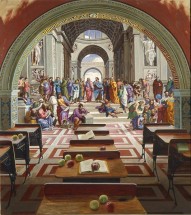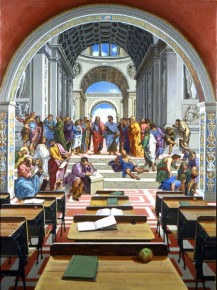Related Works
|
| WorkSchool of Athens II
| Image Notes| Artist's Notes
School of Athens II. Notes by the artist.The painting is signed and dated on the lower left. Commissioned by Atlandia Designs for Mirage Resorts, Las Vegas, Nevada, through Nancy Hoffman Gallery, New York, 1998.
Schools and Schoolrooms. School is a word with many meanings. A school is of course a place for teaching and learning. When I say I studied at the School of the Art Institute of Chicago, I name an institution of learning. I may also use the word to describe any learning experience, such as lessons learned in the school of hard knocks. Fish swim in schools. Like-minded artists, committed to an idea of what a painting should be or how painting ought to be done, group themselves into schools such as the Hudson River School or the Impressionist School. Students of an artist who emulate their teacher, along with others who paint in the manner of that artist, may be identified as belonging to, say, the School of Rembrandt. In his High Renaissance fresco painting The School of Athens Raphael depicts the philosophers and thinkers, beginning with the Greeks, who have shaped the Western mind. He places Plato and Aristotle at the center of his composition, standing side by side under an immense vault. Plato, with a long white beard and wearing a red robe, points upward to heaven as the abode of the archetypal ideas of which, in his philosophy, the actual things we know are mere copies. Aristotle stretches his right hand out over the earth and toward us the viewers, a gesture expressive of his teaching that knowledge is not something handed down from above but rather something that we gain through our actual experience.The figures are grouped in discussion or isolated in meditative silence. They exemplify various schools of thought within the Western tradition. Throughout Raphael's picture he shifts metaphorical levels, for example by including such familiar schoolroom props as books, slates, and globes. In the lower right of his painting, he has the bald-headed Euclid bending over and holding a compass to demonstrate a theorem in geometry. In my painting, I have introduced the furniture of the schoolroom, school desks lined up in rows facing the teacher. I have also placed apples on those desks. Art Quotation (quoting the work of other artists) In The School of Athens Raphael quotes the work of both Leonardo da Vinci and Michelangelo. The features of the red-robed Plato with a long white beard are quoted from a self-portrait by Leonard da Vinci in his old age. The upraised forefinger pointing heavenwards is a signature gesture of Leonardo's seen in several of his paintings.The seated foreground figure of Heraclitus who uses a block of marble as a writing surface is a portrait of Michelangelo. Raphael here quotes Michelangel's style as seen in the monumental figures on the ceiling of the nearby Sistine Chapel. Composition and Format. The forward arch occupying two-thirds of my canvas is an organizing element in my composition. It acts in concert with the blue-and-gold pilasters on either side and with the red plaster wall above the arch to establish a visual plane that divides the space of Raphael's picture from that of my school desks in the foreground. Raphael's picture is situated behind that visual plane. My school desks are placed in front of it. Raphael's figures and architectural elements appear to recede into space. My school desks come forward, toward the viewer.In order to accommodate the vertical format of my canvas, I have re-proportioned the principal arch. In consequence, several figures on either side of Raphael's picture, including one with his self-portrait, have dropped out of my painting behind the newly positioned blue-and-gold pilasters. Perspective. I use two perspective points in School of Athens II. I have extended Raphael's red-and-white marble floor, bringing it forward to make a space for my school desks. In doing so, I keep Raphael's single vanishing point on the left hand of the red-robed figure of Plato/Leonardo, the hand holding a book. For my school desks however, I have made a second vanishing point in the marble riser of the top step, between the seated figure of Heraclitus/Michelangelo on the left and that of Diogenes on the right. This allows my school desks to occupy their own space in front of Raphael's picture without intruding upon his pictorial space. If we the viewers were to sit at those desks we would be looking at Raphael's fresco. Color. I use cool limited color for the schoolroom area up front and the abundant aggressive coloring of Roman High Renaissance painting in my quotation of The School of Athens. Two reds are important in Raphael's picture, an earth red for the marble floor and a bright cadmium red that he uses only for the robe of Plato/Leonardo at the perspective point of his composition. I have kept his color for the marble floor under my school desks and I have used this same earth red in its pure form to define a plaster wall above the principal arch.(George Deem, New York, September 14, 1998). "The History of Art"...This chapter begins appropriately near the beginning of Western painting with my response to Raphael's canonical School of Athens (p. 17). Raphael's picture in one-point perspective is a wall painting in fresco. My School of Athens is painted in oil on canvas. A painting on canvas is a portable object. Among other things that can be done with it, it can be bought and sold. The final image in this chapter is Auction (pp. 30-31). School of Athens, 1998 (p. 17) The School of Athens (1509-11) is a fresco painting by Raphael on the wall of a room in the Vatican. Philosophy is Raphael's theme: the figures exemplify various schools of thought within the Western tradition. At the center are Plato and Aristotle, standing side by side in an imaginary architectural setting expressive of High Renaissance ideals of scale, magnificence, and harmony. Raphael -- shifting metaphorical levels -- punctuates his scene with such schoolroom props as books and slates and globes. In my School of Athens, I introduce the furniture of the schoolroom, desks lined up in rows facing the teacher. (George Deem, How To Paint A Vermeer, page 16). |
Works
| WorkSchool of Athens II
| Image Notes| Artist's Notes |

